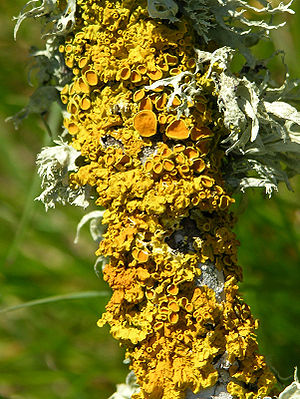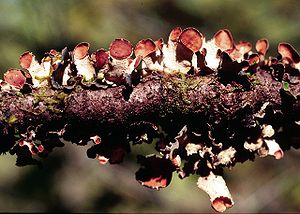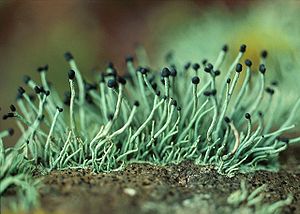Lichens: Difference between revisions
| Line 60: | Line 60: | ||
==Lichen Nutrition== | ==Lichen Nutrition== | ||
Lichen has been studied widely to address the relationship between the symbiosis and nutrient uptake.In a study, using nitrate as the nutrient source, researchers reported that at a critical level or less than the critical level of nitrate concentration, both photobiont and mycobiont shows similar rate of growth. | Lichen has been studied widely to address the relationship between the symbiosis and nutrient uptake.In a study, using nitrate as the nutrient source, researchers reported that at a critical level or less than the critical level of nitrate concentration, both photobiont and mycobiont shows similar rate of growth <sup>[9]</sup>. | ||
==Lichen reprodcution== | ==Lichen reprodcution== | ||
Revision as of 14:55, 8 April 2010
Introduction
Lichens are a form of symbiotic association of fungi and algae. Lichens can also be formed by symbiotic association between fungi and cyanobacteria.The fungal partner in the lichen association is the "mycobiont", and cyanobacterial (or algal) partner is the "photobiont".Lichens are unique organisms that can be found in different and contrasting environments. For example, lichens are found growing in Alaskan Tundra as well as in African Sahara desert.Lichens are morphologically diverse and found in different forms resembling even plants and fungal fruiting body. Lichens grow at very slow pace, a few millimeters a year and take a lot of time to establish on the substrate. From the size of the lichens that is around us we can estimate their age. Lichen structures growing on forest trees and the lichens surviving on rocks can be very old, some times even million years old. For example, in recent years, researchers have identified lichen as old as 600 million years through analysis of fossil and phylogenetic data [2]. Lichens play a significant ecological role as it can colonize barren earth and rock and make the harsh environment to a fertile one where other organisms can start establishing themselves [1].In addition, some species of lichens inhabiting forests are important in providing food and shelter for birds and animals [3]. Further, lichens are being used as ecological indicators of pollution as they are very sensitive to changes in the environment.
Other examples:
Bold
Italic
Subscript: H2O
Superscript: Fe3+
Other examples:
Bold
Italic
Subscript: H2O
Superscript: Fe3+
This template gives you a general idea of the layout of your page. You are not completely restricted to this format, so feel free to try out different things. I'll give you feedback as you work on your pages. Make sure to copy the "code" of this page to your own page before editing. -Prof Kent
In the introduction, briefly describe the habitat that is the topic of this page. Introduce the habitat, its ecological significance, and the importance of microorganisms in this environment. (What processes do they carry out? What functions do they perform?)
Classification
Lichens are classified to three major groups based on their thallus structure. They are Crustose lichens,Foliose lichens and Fruticose lichens [6].
Crustose lichens
Crustose lichens grow holding tightly to their substarte, which may be rocks or trees. Subtypes of crustose lichens are [5],
Powdery or Leprose
Endolithic
Endophloeodic
Squamulose
Peltate
Pulvinate
lobate
Effigurate
Suffruticose
Foliose lichens
Fruticose lichens
Diversity of the association
Ascomycetes and basidiomycetes are the main 'lichenized' fungal groups and majority of fungal partners (more than 95%) in lichen association belong to Ascomycetes [8]. Photobiont partners in the lichen association comes from 40 genera of cyanabacteria and algae when combined together [8].
Symbiosis
Symbiotic association between the fungus and cyanobacteria(or algae) is a complex one. Fungal partner is responsible for the main structural framework of the lichen which is the 'thallus'.The photobiont stays inside the thallus and the mycobiont facilitates the gas exchange and light availability for the photobiont [6].Photobiont cells carry out photosynthesis and provide nutrients for fungus. The fungal partner in turn helps algae with improved water and nutrient uptake and also helps to survive under extremely unfavorable environmental conditions as a unit.
Lichen Nutrition
Lichen has been studied widely to address the relationship between the symbiosis and nutrient uptake.In a study, using nitrate as the nutrient source, researchers reported that at a critical level or less than the critical level of nitrate concentration, both photobiont and mycobiont shows similar rate of growth [9].
Lichen reprodcution
Lichen undergo both sexual and asexual reproduction. Fragmentation is the most common method of lichen asexual reproduction.In fragmentation, a section of parent symbiont can develop in to a new lichen.Soredium and isidium are the two types of vegetative reproductive structures of lichens. Isidium grows out of the thallus and contains both photobiont and mycobiont cells covered by the cortical layer of thallus. Soredium is the other vegetative structure of lichens capable of 'independant growth'. Soredium also has photobiont cells wrapped mycobiont structures but, it is morphologically different from isidium. Isidium can be simple,branched cylindrical and scale like while soredium, most often has a powdery appearance.
Ecological importance
What kind of microbes do we typically find in this environment? Or associated with important processes in this environment? Describe key groups of microbes that we find in this environment, and any special adaptations they may have evolved to survive in this environment. Add sections/subsections as needed. Look at other microbe listings in MicrobeWiki. Are some of the groups of microbes from your environment already described? Create links to those pages. Specific microbial populations will be included in the next section.
Primary succession
Weathering of rocks
Pollution indicators
Current Research
Enter summaries of recent research here--at least three required
References
Edited by student of Angela Kent at the University of Illinois at Urbana-Champaign.




